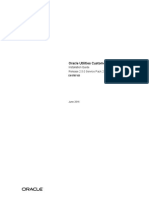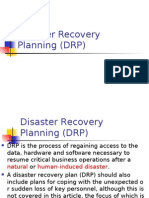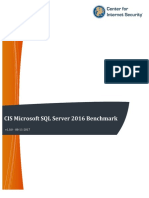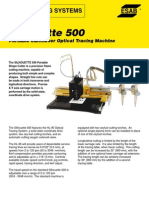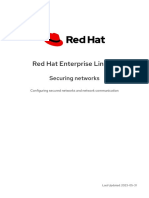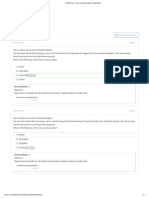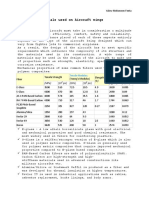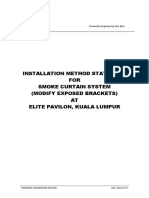Backing Up A Domain and Upgrading Weblogic Server
Backing Up A Domain and Upgrading Weblogic Server
Uploaded by
Netting NichoCopyright:
Available Formats
Backing Up A Domain and Upgrading Weblogic Server
Backing Up A Domain and Upgrading Weblogic Server
Uploaded by
Netting NichoOriginal Title
Copyright
Available Formats
Share this document
Did you find this document useful?
Is this content inappropriate?
Copyright:
Available Formats
Backing Up A Domain and Upgrading Weblogic Server
Backing Up A Domain and Upgrading Weblogic Server
Uploaded by
Netting NichoCopyright:
Available Formats
Backing Up a Domain and
Upgrading WebLogic Server
Copyright 2014, Oracle and/or its affiliates. All rights reserved.
Objectives
After completing this lesson, you should be able to:
Back up a WebLogic Server domain
Restore a WebLogic Server domain
Describe the WebLogic Server upgrade process
17 - 2 Copyright 2014, Oracle and/or its affiliates. All rights reserved.
Backup and Recovery
Backup Recovery
Scheduled Unscheduled (usually)
At least weekly At least annually (if
Uses different tools for only to test procedures)
different components Not necessarily the reverse of
backup; it may use other tools
Backup and recovery:
Protect against failures of hardware or software, and accidental
or malicious changes to the environment
Guarantee a point of recovery and minimize loss of business
availability
May impact system availability (the system must be offline for an
offline backup)
May include hardware and software
17 - 3 Copyright 2014, Oracle and/or its affiliates. All rights reserved.
Backup Solution
Artifacts that need to be backed up include the database,
installed products, configured WebLogic domains,
WebLogic Server instances, and persistence stores for
WebLogic Server TLogs (transaction logs) and JMS
resources.
Use Oracle Recovery Manager (RMAN) to back up
database artifacts.
Use file copy to back up product installations and
configured domains, WebLogic Server instances, and
persistent stores.
You can also use the pack utility to back up managed
servers.
17 - 4 Copyright 2014, Oracle and/or its affiliates. All rights reserved.
Types of Backups
Online:
Non-disruptive
Possibly inconsistent
If backing up takes one hour, the changes made during that
hour will not be within the backup and must be tracked
Offline:
Requires all processes to be stopped
Relatively easy
Full:
Easier to recover, slower to create
Incremental:
Harder to recover, faster to create
17 - 6 Copyright 2014, Oracle and/or its affiliates. All rights reserved.
When to Back Up
Offline backup after the initial domain is created
Online backups at scheduled intervals
Online backup after a component changes or the cluster
configuration changes
Online backup before application deployment
Offline backup before and after patches or upgrades
Online database backups for:
LDAP
Persistent stores
SOA repository
17 - 8 Copyright 2014, Oracle and/or its affiliates. All rights reserved.
Limitations and Restrictions for Online Backups
Online backups of WebLogic Server persistent stores are
likely to be inconsistent (changes can occur while you are
backing up).
Database backups can more easily accommodate
inconsistencies.
File-based stores and OS copies cannot easily
accommodate online backup.
17 - 9 Copyright 2014, Oracle and/or its affiliates. All rights reserved.
Performing Full Offline Backup
1. Shut down all the processes.
2. Back up <MW_HOME>.
3. Back up the domain.
4. Back up directories from which applications are deployed.
5. Back up the managed server domains on other machines
or re-create their domains with the pack/unpack utilities.
6. Back up the instance home for configured system
components (like OHS).
7. Back up the database using RMAN.
8. Back up Oracle Inventory.
9. Back up the oraInst.loc and oratab files (in /etc).
17 - 10 Copyright 2014, Oracle and/or its affiliates. All rights reserved.
Performing Full Online Backup
1. Lock the WebLogic Server configuration.
2. Back up the domain. For example:
$> tar -zcpf domain_backup_04-12-2013.tarz /domain_dir/*
3. Back up the application directories.
$> tar -zcpf app_backup_04-12-2013.tarz /app_dir/*
4. If the managed servers are in another location, back up
those domain directories.
5. Back up the Oracle instance home.
6. Back up the database with RMAN.
17 - 12 Copyright 2014, Oracle and/or its affiliates. All rights reserved.
Impact of Administration Server Failure
Failure of the administration server:
Prevents configuration changes in the domain
Prevents application deployments
Does not affect running managed servers
Prevents starting never-started-before managed servers
Allows starting previously-started managed servers if
Managed Server Independence (MSI) mode is enabled
MSI is enabled by default
Periodically, the managed servers attempt to synchronize
configuration data with the administration server.
When the administration server becomes available, the
managed servers get the latest configuration data from the
administration server.
17 - 14 Copyright 2014, Oracle and/or its affiliates. All rights reserved.
Automatically Backing Up
a Domain Configuration
Enabling this attribute causes a JAR file of the entire config
directory to be created each time a configuration change is
activated.
Disabled by default
How many archives
to save
17 - 15 Copyright 2014, Oracle and/or its affiliates. All rights reserved.
Recovery Operations
Some of the common recovery operations include restoring:
A Middleware home
An Oracle home
An Oracle WebLogic Server domain
The administration server configuration
A managed server
An Oracle instance
Fusion Middleware system component configurations and
data
17 - 16 Copyright 2014, Oracle and/or its affiliates. All rights reserved.
Directories to Restore
Binaries (installation directories)
Be mindful of preserving group ownership and permissions.
These should be read-only for most users.
Configurations
If the last configuration caused the problem, recover to a
point in time prior to that.
Log files are:
Not required for recovery
Created if they do not exist
Data
Database restores data within tablespaces, not directories.
RMAN restore brings data up to the last backup,
then recover brings data up to a later point in time.
17 - 19 Copyright 2014, Oracle and/or its affiliates. All rights reserved.
Recovery After Disaster
Possible causes of failure:
Data loss
User error
Malicious attack
Corruption of data
Media failure
Application failure
Recovery depends on the cause:
Repair
Replace
Relocate
17 - 20 Copyright 2014, Oracle and/or its affiliates. All rights reserved.
Recovery of Homes
This applies to recovering a Middleware home, an Oracle
home, or an Oracle instance home after data loss or corruption:
1. Stop all processes.
2. Make a new full offline backup as a checkpoint (which can
be reused).
3. Change directory to the affected home.
4. Use the OS copy, tar -x, or unzip command for the
directories affected.
5. Make a new full offline backup (especially if you have been
performing incremental backups up until this point).
6. Restart all processes: A. Database listener B. Database
C. Oracle instances (OHS, OID) D. Node Manager
E. Administration server F. Managed servers
17 - 21 Copyright 2014, Oracle and/or its affiliates. All rights reserved.
Recovery of a Managed Server
If the managed server fails, Node Manager will
automatically restart it (if it started it).
If the files are damaged, you can recover the files in their
original places and restart the managed server.
If the computer is damaged, perform either of the following:
Restore the files on a new host with the old computer name
by using the OS commands, for example, copy, cp, tar, or
unzip. (If you backed up by using pack, restore by using
unpack.)
Restore the files on another host with a different host name
by using pack and unpack.
If you used a virtual host name on the old computer, then even if the new
computer has a different name, you can still use OS commands to restore
the files. Just assign the new computer the same virtual host name.
17 - 22 Copyright 2014, Oracle and/or its affiliates. All rights reserved.
Recovery of the Administration Server
If the administration server fails, and it was started by
using Node Manager (through a WLST script), then Node
Manager automatically restarts it.
If the files are damaged, you can recover the files in their
original places and restart the administration server.
If the computer is damaged, restart the administration
server on a new computer.
17 - 23 Copyright 2014, Oracle and/or its affiliates. All rights reserved.
Restarting the Administration Server on a
New Computer
To create a backup of the administration server:
1. Install Oracle WebLogic Server on the backup computer.
2. Copy the application files to the backup computer.
3. Copy the configuration files (or the domain) to the backup
computer.
4. Restart the administration server on the backup computer.
Note that steps Assign it
1, 2, and 3 adminhost adminhost the same
must be AdminServer AdminServer host
completed 192.168.0.1 192.168.0.2 name.
BEFORE the
admin server
failure.
DNS Server managed1 managed2
Update
the DNS adminhost = 192.168.0.11 192.168.0.12
Server.
192.168.0.2
17 - 24 Copyright 2014, Oracle and/or its affiliates. All rights reserved.
Managed Server Independence
Managed Server Independence (MSI) mode reduces the
urgency to restart a failed admin server.
Enabled
by default
17 - 26 Copyright 2014, Oracle and/or its affiliates. All rights reserved.
Upgrading WebLogic Server 11g to 12c
1. Plan the upgrade.
A. Inventory the environment (admin server, managed servers,
applications, external resources, scripts/templates).
B. Verify that all hardware and software components are
supported.
C. Verify the compatibility of your applications.
D. Create an upgrade plan.
2. Prepare to upgrade
A. Undeploy incompatible applications.
B. Shut down servers.
C. Back up the environment.
D. Install new Oracle products.
E. Prepare remote managed server domains.
F. Set up environment variables.
17 - 27 Copyright 2014, Oracle and/or its affiliates. All rights reserved.
Upgrading WebLogic Server 11g to 12c
3. Upgrade Run the
Oracle
Upgrade
Assistant(s)*
Start
Yes
Back up the Are there No
Run the re- Are FMW
domain on remote
configuration products
the admin managed
wizard installed? No
server servers?
(Details later)
Yes
(Details later)
Back up the Upgrade the
* Refer to the FMW installation or domain on managed
End
upgrade guides for the products remote server
you are using. machines domains
17 - 29 Copyright 2014, Oracle and/or its affiliates. All rights reserved.
Run the Reconfiguration Wizard
A. In the terminal
window, run
<MW_HOME>/
oracle_common/
common/bin/
reconfig.sh.
B. Go through the
wizard screens.
C. Manually finish the
Node Manager
configuration.
17 - 30 Copyright 2014, Oracle and/or its affiliates. All rights reserved.
Upgrade the Managed Server Domains
A. Ensure that during the preparation phase, you copied
these files from the pre-upgraded admin server domain
directory to the managed server domains root directory:
/config/config.xml and
/security/SerializedSystemIni.dat.
B. Port the reconfigured domain from the admin server
computer to the managed server computers with pack and
unpack.
17 - 31 Copyright 2014, Oracle and/or its affiliates. All rights reserved.
Upgrading WebLogic Server 11g to 12c
4. Complete post-upgrade procedures:
A. Re-apply any customizations you had in server start scripts.
B. Verify and reset file permissions (in Linux, file ownership
goes to the user that did the upgrade).
C. Verify server start options (for example, JAVA_HOME and
CLASSPATH may need to be updated for servers started via
Node Manager).
D. After the environment has been tested, move it to
production.
17 - 32 Copyright 2014, Oracle and/or its affiliates. All rights reserved.
Quiz
The administration server of the domain has failed. Can a
managed server currently not running be started?
a. Yes, if Managed Server Independence Mode is enabled
and the server has been started before.
b. No, a managed server must always contact its admin
server when it comes up.
17 - 33 Copyright 2014, Oracle and/or its affiliates. All rights reserved.
Summary
In this lesson, you should have learned how to:
Back up a WebLogic Server domain
Restore a WebLogic Server domain
Describe the WebLogic Server upgrade process
17 - 34 Copyright 2014, Oracle and/or its affiliates. All rights reserved.
Practice 17-1 Overview:
Backing Up and Restoring a Domain
This practice covers the following topics:
Backing up a domain
Restoring a domain
17 - 35 Copyright 2014, Oracle and/or its affiliates. All rights reserved.
You might also like
- Setting Up The Darktrace ApplianceDocument24 pagesSetting Up The Darktrace ApplianceRobinson Garcia GarciaNo ratings yet
- OCI Operations Professional WorkshopDocument20 pagesOCI Operations Professional WorkshoprtaparayNo ratings yet
- Hardening Oracle Linux ServerDocument4 pagesHardening Oracle Linux ServerTran HieuNo ratings yet
- Qualys Multi-Vector EDR: Lab Tutorial SupplementDocument24 pagesQualys Multi-Vector EDR: Lab Tutorial SupplementPremdeepakHulagbaliNo ratings yet
- Ibm Openpages Operational Risk Mamagement Software SolutionDocument4 pagesIbm Openpages Operational Risk Mamagement Software SolutionJamil BellaghaNo ratings yet
- CITM Course BrochureDocument4 pagesCITM Course BrochureIT AdminNo ratings yet
- Active Directory Migration Strategy A Complete Guide - 2020 EditionFrom EverandActive Directory Migration Strategy A Complete Guide - 2020 EditionNo ratings yet
- What Is Strategic ThinkingDocument6 pagesWhat Is Strategic ThinkingMarco AlvarezNo ratings yet
- (Topics in Organometallic Chemistry Vol.2) Shu Kobayashi - Lanthanides - Chemistry and Use in Organic Synthesis - Springer (1999)Document303 pages(Topics in Organometallic Chemistry Vol.2) Shu Kobayashi - Lanthanides - Chemistry and Use in Organic Synthesis - Springer (1999)Hakeem AfridiNo ratings yet
- Two - Diet PlanDocument1 pageTwo - Diet PlanmanavchopraNo ratings yet
- Oracle® Fusion MiddlewareDocument132 pagesOracle® Fusion MiddlewareRahul RoyNo ratings yet
- EPO Web API Scripting Guide En-UsDocument40 pagesEPO Web API Scripting Guide En-UsdanipajbrNo ratings yet
- Red Hat Enterprise Linux 7 Hardening ChecklistDocument13 pagesRed Hat Enterprise Linux 7 Hardening ChecklistIki ArifNo ratings yet
- CIS IBM DB2 9 Benchmark v3.0.1Document206 pagesCIS IBM DB2 9 Benchmark v3.0.1Andrei SandulescuNo ratings yet
- Maximum Security Architecture: Securing Data at Its SourceDocument9 pagesMaximum Security Architecture: Securing Data at Its SourceSneha PednekarNo ratings yet
- CCB Installation Guide v2 5 0 2Document129 pagesCCB Installation Guide v2 5 0 2Ara Gren-LiNo ratings yet
- AWS Case Study JG HosieryDocument3 pagesAWS Case Study JG HosierySuresh Kumar SNo ratings yet
- Information Security in GeneralDocument12 pagesInformation Security in GeneralAliNo ratings yet
- Qualys Patch Management Getting Started Guide - ENDocument48 pagesQualys Patch Management Getting Started Guide - ENNarciso JuniorNo ratings yet
- LogRhythm Microsoft Office 365 Log CollectionDocument10 pagesLogRhythm Microsoft Office 365 Log CollectionCesar AlmadaNo ratings yet
- Hardening For Windows XP ProfDocument25 pagesHardening For Windows XP Profvishal3479No ratings yet
- CISA 27e CH 5 Protection of Information AssetsDocument192 pagesCISA 27e CH 5 Protection of Information AssetsJa'far NumeiriNo ratings yet
- Understanding and Selecting Data Masking Solutions: Creating Secure and Useful DataDocument33 pagesUnderstanding and Selecting Data Masking Solutions: Creating Secure and Useful DataEntoni_104No ratings yet
- LogRhythm SOAR Ecosystem November 2021Document49 pagesLogRhythm SOAR Ecosystem November 2021pleaiden01No ratings yet
- ARCON - PAM - Deck - Latest - 2021Document19 pagesARCON - PAM - Deck - Latest - 2021shako12No ratings yet
- Disaster Recovery Planning (DRP)Document62 pagesDisaster Recovery Planning (DRP)api-26137220No ratings yet
- Database Security Overview FinalDocument25 pagesDatabase Security Overview FinalvasunewsNo ratings yet
- FortiAnalyzer 5.4.5 Administration GuideDocument196 pagesFortiAnalyzer 5.4.5 Administration GuideFelipe Gabriel Nieto ConchaNo ratings yet
- CIS Microsoft SQL Server 2016 Benchmark v1.0.0Document99 pagesCIS Microsoft SQL Server 2016 Benchmark v1.0.0juanNo ratings yet
- Audit Vault Database Firewall 121212 130205114310 Phpapp01Document28 pagesAudit Vault Database Firewall 121212 130205114310 Phpapp01Irfan Aslam100% (1)
- RBAC ROLE NewDocument16 pagesRBAC ROLE Newgaikwadswapna5No ratings yet
- AWS Auditing WhitepaperDocument21 pagesAWS Auditing WhitepaperwilberNo ratings yet
- Barracuda Web Application Firewall DS USDocument2 pagesBarracuda Web Application Firewall DS USmjsmith11No ratings yet
- 01 Setting Up Identity and Access Management Node PDFDocument35 pages01 Setting Up Identity and Access Management Node PDFKatamReddy Sudhakar ReddyNo ratings yet
- Oracle PaaS and IaaS Public Cloud Services Pillar DocumentDocument123 pagesOracle PaaS and IaaS Public Cloud Services Pillar DocumentCosmeNo ratings yet
- Cisco Ironport and Exchange 2016Document10 pagesCisco Ironport and Exchange 2016shan1512No ratings yet
- CIS Microsoft SQL Server 2008 R2 Benchmark v1.5.0Document92 pagesCIS Microsoft SQL Server 2008 R2 Benchmark v1.5.0Ahmed GadNo ratings yet
- 01 Oracle Audit Vault and Database Firewall Concepts GuideDocument22 pages01 Oracle Audit Vault and Database Firewall Concepts GuideMarcelo OksNo ratings yet
- 03.1.4 Active Directory Identity ManagementDocument3 pages03.1.4 Active Directory Identity ManagementMaheish AyyerNo ratings yet
- Data Loss Prevention Solution enDocument7 pagesData Loss Prevention Solution eninayat1975No ratings yet
- Detail Report v0.1Document60 pagesDetail Report v0.1Waisiki RavulaNo ratings yet
- 02-PAS-ADMIN User ManagementDocument41 pages02-PAS-ADMIN User ManagementMatcha SatishNo ratings yet
- UNIX and Linux Security ChecklistDocument59 pagesUNIX and Linux Security ChecklistAsif MahbubNo ratings yet
- DRP BCP For Risk ManagementDocument18 pagesDRP BCP For Risk ManagementJayath GayanNo ratings yet
- HP Data Protector Best Practice Guide EnuDocument32 pagesHP Data Protector Best Practice Guide EnuClaudioQuinterosCarreño100% (1)
- Perfrom A Wireless AuditDocument3 pagesPerfrom A Wireless Auditmiraclesuresh0% (1)
- FirewallDocument14 pagesFirewallDyfi ManiNo ratings yet
- Database Security ChecklistDocument3 pagesDatabase Security ChecklistvaniirffanNo ratings yet
- How Do I Copy An Oracle DB From One Server To AnotherDocument2 pagesHow Do I Copy An Oracle DB From One Server To AnotherNabil AzougaghNo ratings yet
- WebLogic Administration Server - Failover-HADocument5 pagesWebLogic Administration Server - Failover-HASelva KumarNo ratings yet
- LogRhythm SIEM Components and Data PathwaysDocument1 pageLogRhythm SIEM Components and Data PathwaysYazid UTDNo ratings yet
- Tripwire Executives Guide To The Cis Controls PDFDocument19 pagesTripwire Executives Guide To The Cis Controls PDFcheenuNo ratings yet
- NetScaler 10.5 Application FirewallDocument248 pagesNetScaler 10.5 Application FirewallsudharaghavanNo ratings yet
- As Build Documents - WebLogic Installation and ConfigurationDocument38 pagesAs Build Documents - WebLogic Installation and ConfigurationhaymanotNo ratings yet
- Tripwire TutorialDocument7 pagesTripwire Tutorialjasmina_cipNo ratings yet
- Firewall Audit Work ProgramDocument38 pagesFirewall Audit Work Programchinhgpt189No ratings yet
- 09 Pentesting Routers Braa Nmap NseDocument12 pages09 Pentesting Routers Braa Nmap NseThirumala KakaniNo ratings yet
- Integrate AppsR12 With OID SSODocument36 pagesIntegrate AppsR12 With OID SSOKrunal1986No ratings yet
- Cyber Security Section 1.1 NotesDocument4 pagesCyber Security Section 1.1 NotesHime Crycho100% (1)
- Dynamic Application Security Testing A Complete Guide - 2019 EditionFrom EverandDynamic Application Security Testing A Complete Guide - 2019 EditionNo ratings yet
- Network Channels and Virtual HostsDocument31 pagesNetwork Channels and Virtual HostsNetting NichoNo ratings yet
- Clusters - Overview, Creation, and ConfigurationDocument29 pagesClusters - Overview, Creation, and ConfigurationNetting NichoNo ratings yet
- Clusters - Proxies and SessionsDocument41 pagesClusters - Proxies and SessionsNetting NichoNo ratings yet
- Clusters - Proxies and SessionsDocument41 pagesClusters - Proxies and SessionsNetting NichoNo ratings yet
- Red Hat Enterprise Linux 7 Security Guide en USDocument261 pagesRed Hat Enterprise Linux 7 Security Guide en USTim SwanNo ratings yet
- Patterns of Development DefinitionDocument24 pagesPatterns of Development DefinitionIrene Tagalog100% (1)
- Chapter 8 - NotesDocument20 pagesChapter 8 - NotesPraneethNo ratings yet
- Silhouette 500 PDFDocument2 pagesSilhouette 500 PDFCarlos Padilla0% (1)
- Great Writing 5e Level 2 Unit 2 Exam View TestDocument9 pagesGreat Writing 5e Level 2 Unit 2 Exam View TestXuân Luật Đặng100% (1)
- Red Hat Enterprise Linux 9 Securing Networks en UsDocument94 pagesRed Hat Enterprise Linux 9 Securing Networks en Usbent vaderNo ratings yet
- Development of Education System in Kenya Since IndependenceDocument10 pagesDevelopment of Education System in Kenya Since IndependenceNelsonMoseMNo ratings yet
- AZ-500 Exam - Free Actual Q&as, Page 2 - ExamTopicsDocument6 pagesAZ-500 Exam - Free Actual Q&as, Page 2 - ExamTopicscotit93331No ratings yet
- Standard 5381Document1 pageStandard 5381atul sachanNo ratings yet
- Activity 2 - Moving AveragesDocument4 pagesActivity 2 - Moving AveragesMei MCasNo ratings yet
- Unit 7 Mother NatureDocument15 pagesUnit 7 Mother NatureSainah ManigothNo ratings yet
- Adamczyk Resume 2019 5Document2 pagesAdamczyk Resume 2019 5api-511630954No ratings yet
- Car StarterDocument3 pagesCar Starterapi-509827005No ratings yet
- Lesson Support For Chapter 4 Third Read: Grade 9, Unit 1-Chapter 4 Pp. 60-61Document13 pagesLesson Support For Chapter 4 Third Read: Grade 9, Unit 1-Chapter 4 Pp. 60-61mohamad aliNo ratings yet
- Mobile Computing Unit 1, 2Document276 pagesMobile Computing Unit 1, 2evilanubhav67% (3)
- A Parallel Genetic Algorithm For Performance-Driven VLSI RoutingDocument28 pagesA Parallel Genetic Algorithm For Performance-Driven VLSI RoutingNaveen ChaubeyNo ratings yet
- NILAI 100%: Jawaban IT Essentials Final Exam 1-10 (V 4.1)Document8 pagesNILAI 100%: Jawaban IT Essentials Final Exam 1-10 (V 4.1)Mimi AlbarwaniNo ratings yet
- Writing VocabularyDocument1 pageWriting VocabularyFallsFavouriteFindsNo ratings yet
- Australian Immunisation Handbook - 9th Edition 2008 (NHMRC)Document413 pagesAustralian Immunisation Handbook - 9th Edition 2008 (NHMRC)wmross1100% (1)
- Project Report. Composite Materials Used On Aircraft WingsDocument15 pagesProject Report. Composite Materials Used On Aircraft WingsYalew MekonnenNo ratings yet
- Static Behavior of Natural GasDocument34 pagesStatic Behavior of Natural GasLemony SnickitNo ratings yet
- Optical Properties of MaterialsDocument33 pagesOptical Properties of MaterialsHoang Hop Dang100% (1)
- Hard MomentumDocument10 pagesHard Momentumzeina.abdulal09No ratings yet
- PF-Tek For Simple Minds - FungifunDocument25 pagesPF-Tek For Simple Minds - Fungifunb8777144No ratings yet
- 4 Article TLT Grease AdditivesDocument11 pages4 Article TLT Grease AdditivesYasir ShaikhNo ratings yet
- Pieze Kelvin DatainventoryDocument4 pagesPieze Kelvin Datainventoryapi-370073216No ratings yet
- Elite Pavilion - Method Statement - Smoke Curtain (Adjust Brackets) PDFDocument6 pagesElite Pavilion - Method Statement - Smoke Curtain (Adjust Brackets) PDFJuwe PkdoNo ratings yet
















